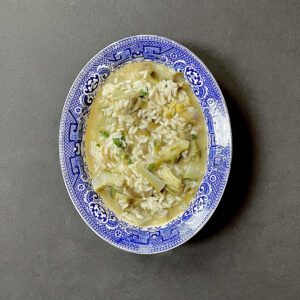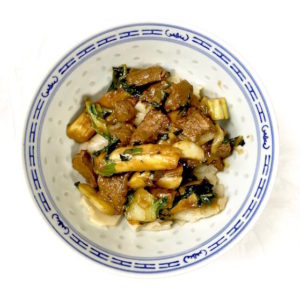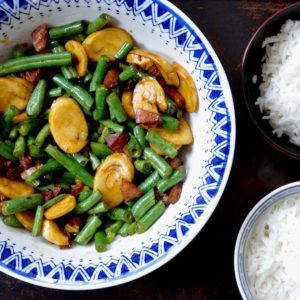On Risotto
Certain foods carry a mystique around their preparation. Whipped cream, souffles, mayonnaise, pie crusts: all are imbued with advice, caveats, admonishments. Your batterie de cuisine must be immaculate, your hands chilly, your heart resolute. Or you must stir until your arm falls off–this exact wording frequently used. Stir until your arm falls off. That sounds like fun. Or, cold hands, cold butter, cold water. And, ideally, a chilly marble slab. I do indeed have cold hands, courtesy of Raynaud’s Syndrome. It’s a bad reason to be good at pie crusts. As for the marble slab, I am no heiress.

Our dirty garage.
I came to preparing the above foods late in life, and by late I mean well into my forties. I’d read too many recipes designed to terrify. They’d done their jobs. Which was unfortunate.
Enter risotto. Here was a dish rife with culinary dangers.
Anyone setting out to learn to make risotto, as I did recently, will find that the hardest part is sorting through the abundance of information and recipes.
John Thorne, “Riso In Bianco,” Pot On The Fire
The above was published in 2000. Matters have worsened since, but Thorne’s essay, like all his writing, makes for instructive reading. In a newsletter entitled “Simple Food” and five award-winning books, Thorne did not encounter recipes so much as wrestle them to the mat. Risotto was no exception. He has since dropped off the face of the earth, much to the dismay of his fans.

Downtown Berkeley. Normally this place would be mobbed–I mean packed–with students, shoppers, senior citizens, and crazy people. Now….nobody.
—
Risotto makers are much esteemed in kitchens and dining rooms, as though risotto were somehow more demanding than a fine plate of pasta.
Judy Rodgers, The Zuni Cafe Cookbook
May Ms. Rodgers rest in peace. Risotto is more demanding than a fine plate of pasta.

Whatever your clock, if you want risotto, you must stir to acheive it. Many are the writers who warn you about said stirring: if not until your arm falls off, well, close to it.
You must never stop stirring…..
Marcella Hazan, Essentials Of Classic Italian Cooking
In an ideal world, that is, one without a pandemic and subsequent lockdown, you could prepare your risotto in peace. Your neighbors would not be whooping at their televisions. Their toddlers would not be shrieking. Your kids would not be “distance learning,” in close proximity to you. Your husband wouldn’t go off the wheelchair ramp in the yard, getting one tire stuck in the mud.
You would not be day drinking.

The rice will take around 22 minutes to cook, but the one thing you cannot afford to do is stop stirring for more than a minute or two.
Tamasin Day-Lewis, Tamasin’s Kitchen Classics

Suppose, just suppose, you are interrupted while stirring by one of the above. Or something your hostess hasn’t imagined. Insert interruption here. To place your risotto on pause, breathe deeply. Turn the heat down under rice and broth to the lowest possible blip. If yours is an electric stove, remove the pans from the heat and cover them.
Attend to your interruptions.
Once back at the stove, turn the heat back up. Add liquid to the rice. Resume stirring. I will not tell you calm down. Just try not to kill anybody, least of all yourself. Make risotto.

Risotto making is rather like bread baking: each outing will be slightly different. Sometimes you’ll need all the broth, sometimes not. Sometimes you’ll need more liquid after the broth is used up. Boiling water will do. Some rices inhale liquids rapidly, others are more leisurely. You must pay attention.

Wheelchair derailment made photography difficult. Above, a floral interlude.
Most risotto recipes tell you the dish is ready in twenty minutes or thereabouts. I find it takes more like thirty. As the rice cooks, the grains will swell and thicken, changing color from glassy white to creamy beige. The risotto will look done. It will smell done. Taste. You will know.

People will tell you risotto must be served immediately. In a perfect world, they’re right. Given the world we live in is a complete mess, know risotto will hold over the lowest possible heat in a heavy, lidded pot for about an hour. Take great care with this, or your risotto will swell into congee, which isn’t what you want here.
Also contrary to popular opinion, I have found risotto perfectly good the following day, gently reheated with a bit of water.

Risotto with Asparagus
Yield: 2 servings
Preparation time: about 30 minutes
Ingredients:
10 ounces/270g asparagus, trimmed
about 2 tablespoons unsalted butter
2 small garlic cloves, peeled and minced
1 small onion, peeled and minced, or one lobe of shallot, peeled and minced
about two tablespoons unsalted butter
olive oil
1 cup/350g Arborio, Carnaroli , or Vialone Nano Risotto rice
1/2 cup/4 ounces/120 ml dry white wine or Vermouth
6 cups/1.5L unsalted chicken or vegetable broth
salt and pepper
grated parmesan cheese, to taste
More parmesan, for the table, optional
Instructions
You will need two pans and a plate to prepare the risotto. The plate is for the asparagus, which is briefly sautéed in the same pan we’ll prepare the risotto in. I cook risotto in a Staub “Everyday” pan, which is 10 inches/25cm across and 2.5 inches/6cm deep. It’s ideally sized for risotto making. The other pan is for the broth.
Start by trimming your asparagus. People are incredibly opinionated when it comes to asparagus trimming, so do what you want. Slice the spears into bite-sized pieces and melt a little butter in your risotto pot.
Drop the asparagus in. Sauté for a few minutes over medium heat. Remove to the waiting plate.
Okay. Put your broth pan on the stove and pour the broth into it. You need six cups, give or take, and you need it hot. Not boiling, but a nice simmer.
Turning back to the rice pan. Add the second bit of butter, and a little bit of olive oil–about a tablespoon. Medium low heat. Now add the garlic and onion (or shallot). Cook gently for a couple minutes.
Pour in the rice, and give it a good stir around the pot, coating it with butter. Once the grains are shiny with fat, pour in the wine or Vermouth. Stir. Lots.
You may need to adjust the heat here; it needs to be warm enough to let the rice absorb the liquid but not so hot the rice starts sizzling and burning. Trust your eyes and, importantly, your nose. Americans are rarely taught to use their sense of smell while cooking. Try it.
Stir, stir, stir. Once the wine is absorbed, start adding the broth. I use a small ladle; it holds about three tablespoons. You’ll get a sense and quickly establish a rhythm. For the first 15-20 minutes or so, the rice will feel hard against the spoon and appear chalky. As it absorbs the broth, the grains will expand and soften. The rice will go from hard white to a softer cream color.
If you run out of broth before the rice is done, add water to the broth pan, heating to simmer, and add to the rice until it’s done. Once the risotto is ready, add a final ladle of liquid and taste for seasoning. Stir in the asparagus and add parmesan to taste. It is best to serve risotto at once, but you can turn the heat all the way down, cover the pot and hold the risotto for an hour. Any more than that and you’ll have congee.
Leftover risotto will keep, refrigerated, up to three days. Do not freeze.
Notes:
You want to use the best possible broth here. If you don’t make your own, much as it makes me shudder, now is the time to buy that fancy bone broth in twee jars people are charging stupid money for. But really, if you can be coaxed into making your own broth, now is the time for it.
I use Vermouth in place of white wine, which I rarely have in the house.
Variations are endless: add other vegetables such as peeled cooked fava beans, fresh peas, minced sauteed zucchini, chicken, ham, shellfish, on and on.
The literature on risotto is enormous; this post isn’t even the tip of a (rapidly melting) iceberg.
For additional reading and recipes, here are a few starting places:
Jeffrey Alford and Naomi Duguid: Seductions Of Rice
Anna Del Conte: Gastronomy of Italy
Marcella Hazan: The Essentials Of Classic Italian Cooking
Sri Owen: The Rice Book
John Thorne: Pot On The Fire





